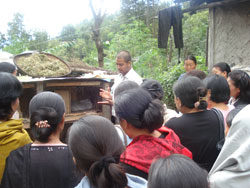 People of Nagaland are predominantly non-vegetarian and relished meat from a variety of possible sources. Common domestic animals used for meat are pig, cattle, buffalo, goat, poultry and dogs. Despite very high demand for the animal products in the region, the livestock reared in the state for the production of meat, egg, milk etc. are of inferior genetic makeup and therefore produce comparatively less meat. An attempt was made by Krishi Vigyan Kendra (NRC on Mithun), Phek, Nagaland, to lessen the deficit of meat (6520 MT/annum) in Phek district by popularising backyard rabbitry among the tribal communities as a source of quality meat and livelihood option. The aim of the programme was to popularize rabbitry so that each household of the village should have minimum a pair of rabbit.
People of Nagaland are predominantly non-vegetarian and relished meat from a variety of possible sources. Common domestic animals used for meat are pig, cattle, buffalo, goat, poultry and dogs. Despite very high demand for the animal products in the region, the livestock reared in the state for the production of meat, egg, milk etc. are of inferior genetic makeup and therefore produce comparatively less meat. An attempt was made by Krishi Vigyan Kendra (NRC on Mithun), Phek, Nagaland, to lessen the deficit of meat (6520 MT/annum) in Phek district by popularising backyard rabbitry among the tribal communities as a source of quality meat and livelihood option. The aim of the programme was to popularize rabbitry so that each household of the village should have minimum a pair of rabbit.
 Rabbit being highly prolific and fast growing found to be the better option to address the issue related to meat deficiency in the region. Early maturity, short gestation period, higher litter size per kindling and fewer incidences of diseases were the added advantages. Initially rabbitry was introduced in 2008-09 as pilot study programme in two villages of the district i.e. Porba Upper Khel and Gidemi. Subsequently in the next year after realizing the initial success and acceptability among the farmers in these two villages, the programme was extended in another five villages i.e. Sakaraba, Porba Lower Khel, Pfutseromi, Kikruma and Thevopisü.
Rabbit being highly prolific and fast growing found to be the better option to address the issue related to meat deficiency in the region. Early maturity, short gestation period, higher litter size per kindling and fewer incidences of diseases were the added advantages. Initially rabbitry was introduced in 2008-09 as pilot study programme in two villages of the district i.e. Porba Upper Khel and Gidemi. Subsequently in the next year after realizing the initial success and acceptability among the farmers in these two villages, the programme was extended in another five villages i.e. Sakaraba, Porba Lower Khel, Pfutseromi, Kikruma and Thevopisü.
Horizontal sharing of rabbit kids among the members of Self Help Groups was planned as a strategy to promote this animal among the farm women under backyard rabbitry programme. After three year of intervention, it was observed that the rabbitry is well adaptable under the backyard conditions in Phek and it was adopted by all categories of the farmers. 240 farm women were the primary beneficiary and it was further expanded to another 210 farm families as secondary and tertiary beneficiaries. The cumulative gain realized by all the families through backyard rabbitry is about Rs. 27.92 lakhs in a year. This experience shows that the novel idea of horizontal sharing of kids could be a better approach for rapid and efficient dissemination of technology among the tribal communities in the region and rabbitry can be adopted as successful vocational enterprise in North East Hill Region.
(Source: NAIP Sub-Project on Mass Media, DKMA with inputs from NRC on Mithun, Nagaland)







फेसबुक पर लाइक करें
यूट्यूब पर सदस्यता लें
X पर फॉलो करना X
इंस्टाग्राम पर लाइक करें